I recently replaced the MSI MEG X670E Ace in my benchtable with the MSI MPG X870E Carbon WiFi because a new (old) chipset for the Ryzen 9000 feels better and Intel is also releasing a new chipset together with Arrow Lake S into the product cycle. Just between you and me: in terms of performance, this stunt is superfluous, but with USB 4.0 and WiFi 7, I want to remain at least somewhat future-proof. I don’t want to hide the fact that some points are also a step backwards, but MSI has simply omitted the direct successor to the Ace.
There seems to be no room left between the Carbon WiFi and the Godlike for the Ace, because the MSI MPG X870E Carbon WiFi has been improved considerably. Others say cannibalization, but I at least mourn my 10G Ethernet and am happy about one or two features that ultimately make my life and testing much easier. So somehow it’s all a trade-off with compromises. And that’s exactly what I’m writing about today, because in terms of pure performance, the whole thing makes no difference. Basically, AMD has just elegantly upgraded the chipset and added a few features. USB 4.0 would also have been an option on the X670E. It largely runs externally.
Since there are already benchmarks for the MSI MEG X670E like sand on the sea, I will forego this redundancy and not widen the beach significantly, because some plausibility tests in the workstation and gaming area see both boards completely on par. However, the Ryzen 9 9950X performs a little better in a few applications on this board, but this may also be due to the special BIOS version. However, a pure unboxing would also be boring, so today I will limit myself to my conversion in the specific application area and various technical details that still promise tangible added value. But since it seems that everyone already had at least one mainboard test online yesterday, I’m going to take a back seat today and deliver one too. Just a little differently and in my own way. And for the first time, there will also be a cross-check of the installed thermal pads, which MSI advertises as 7 W/m-K. Nobody in the world has ever had that before.
Features, technological differences and technical data
Although the MSI MPG X870E Carbon WiFi with an RRP of 479 euros is 50 euros more expensive than the street price of 429 euros of its direct predecessor with the X670E chipset, it offers significantly more and comes very close to the currently omitted MSI MEG X670E Ace, which is currently significantly more expensive at over 800 euros, if you can still get it at all. In terms of power supply and cooling, the new Carbon is also completely sufficient for use in my benchtable and is actually already completely oversized. But reserves have never done any harm and an X870E Godlike would be a wonderful nice-to-have, but due to the price alone it would be decadent to use it on the benchtable with CPUs, SSDs, graphics cards and the obligatory thermal paste. Incidentally, the DOWSIL TC-5550 is used here in the form of the PastX 45 from X-Apply.
People are creatures of habit and I have rarely had a bad experience with the MSI BIOSes on the benchtable. Everything almost always worked right away and I don’t want to hide the fact that I prefer the rather conservative design of the settings to all the OC and gaming stuff, which simply has no place on a device that I also and above all test productive applications with. Non-transparent factory OC for the longest benchmark bar is completely suspect to me personally. Others may certainly see it differently and I don’t begrudge them that. But I deliberately take myself out of it. Even with Intel systems, where I’ve also had CPU losses, but in general I was always on the safe side and it was never due to the board.
But what is the difference between the X870E chipset and the X670E, which both use 44 lanes, and between the two boards?
Connectivity and network support:
The X670E generally only supports Wi-Fi 6E, which offers 6 GHz WLAN for faster speeds and less congestion. The X870E, on the other hand, is designed for Wi-Fi 7, which offers higher data rates, improved latency and more efficient channel utilization than Wi-Fi 6E. This makes the X870E more suitable for future network standards, although you always need to consider if and when you will be upgrading yourself.
Performance and power supply:
The newer Carbon WiFi with the X870E uses a stronger power supply with more phases (18 2 1) and higher quality components designed for more extreme overclocking scenarios and even higher power requirements. This makes the Carbon WiFi X870E (according to MSI) particularly suitable for power users and enthusiasts who require maximum performance, as the previous model was weaker in this respect. However, the now discontinued Ace with 24 virtual phases was at least on a par.
Expandability:
The X870E offers more M.2 slots with PCIe Gen 5 support, making it ideal for use in systems with multiple high-speed SSDs. The X670E also supports PCIe 5.0, but in a slightly more limited number of M.2 slots. This means that the X870E offers more options for memory expansions.
AI optimization:
The X870E includes special optimizations for AI computing, making it better suited for future artificial intelligence and machine learning applications. These functionalities are missing in the X670E, which is more focused on general user and gaming applications. Here, too, you have to ask yourself what else would have been possible with the X670E and where the upgrade can only be realized via the firmware. But if AMD doesn’t want to, then that’s probably the way it is.
Finally, I have the data sheet for you before I start the installation.
And for those who don’t recognize anything here on the I/O, the whole thing again as a real photo:
Of course, MSI also had a live stream of the new boards with the X870(E), which I don’t want to withhold from you:
















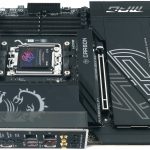



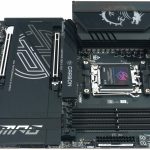
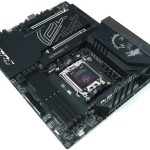
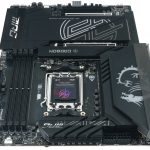
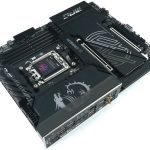




















Kommentieren